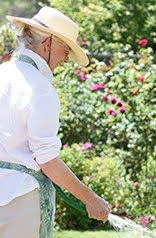I just found out what this fern was not that long ago. I loved it's look on the tree, then it croaked and I wondered what did that. Then I read about this fern and the other day before it rained, I went out and took a picture of it withered, then yesterday after the rain, I took another picture.
I looked in Wikipedia to get info about it, which you can read more about there. I'll just give you a sampling here.
Rather amazing actually.
FlowerLady
This fern is an epiphyte, or air plant, which means it attaches itself to other plants and gets its nutrients from the air and from water and nutrients that collect on the outer surface of bark. The Resurrection fern lives on the branches of large trees such as cypresses and can often be seen carpeting the shady areas on limbs of large oak trees. However, it is known to grow on the surfaces of rocks and dead logs as well. It is often found in the company of other epiphytic plants such as Spanish moss.
The Resurrection fern gets its name because it can survive long periods of drought by curling up its fronds and appearing desiccated, grey-brown and dead. However, when just a little water is present, the fern will uncurl and reopen, appearing to "resurrect" and restoring itself to a vivid green color. It has been estimated that these plants could go 100 years without water and still revive after a single soaking.
When the fronds "dry", they curl with their bottom sides upwards. In this way, they can rehydrate the quickest when rain comes, as most of the water is absorbed on the underside of the leaf blades. Experiments have shown that they can lose almost all their free water and remain alive - up to 97%, though more typically they only lose around 76% in dry spells (Moran 2004). For comparison, most other plants would die after losing only 8-12%. This fern can lose almost all the water not hydrating the cells in its leaves and survive.










4 comments:
Don't know this fern. Great info.
Cameron
One of my favs. It will grow on brick, porous rock, decaying wood, exposed tree roots and branches of live trees.
Here's a little something for your sidebar, If you'd like to use it, in two sizes.
Butterfly Stamp from Nell
Big Butterfly Stamp
Feel free to pass it on.
I don't think something like that would grow here, but I enjoyed looking at yours and reading about it.
Where can I buy some? My live oak trees need Resurrection Fern.
Post a Comment